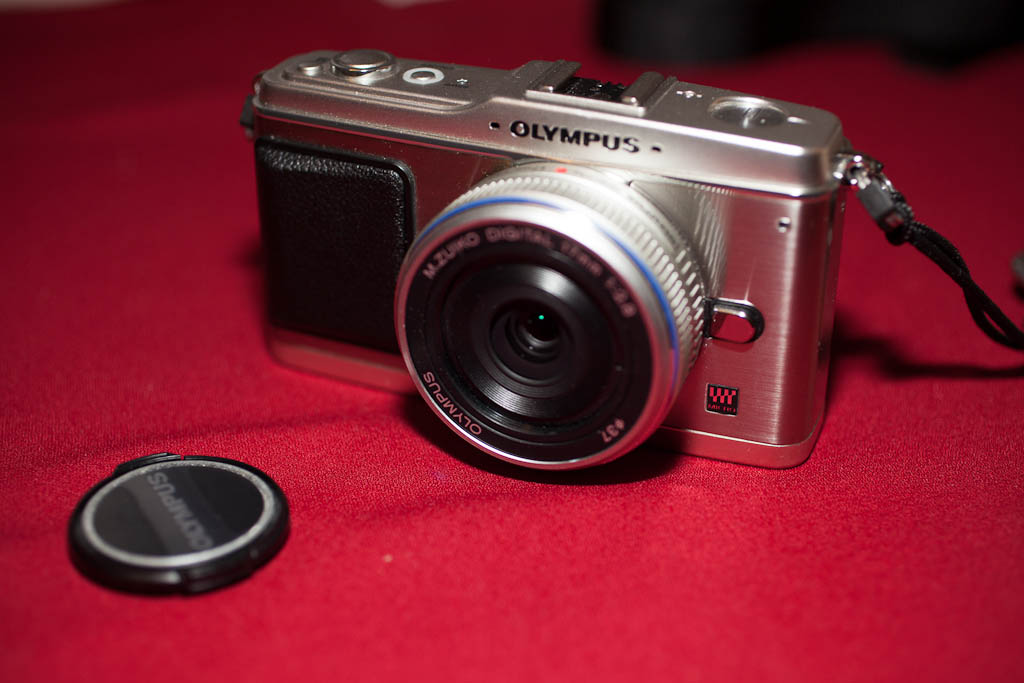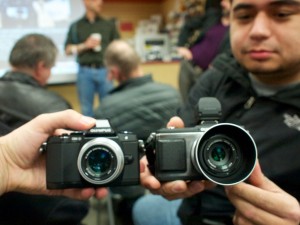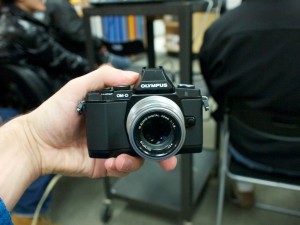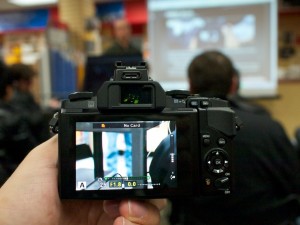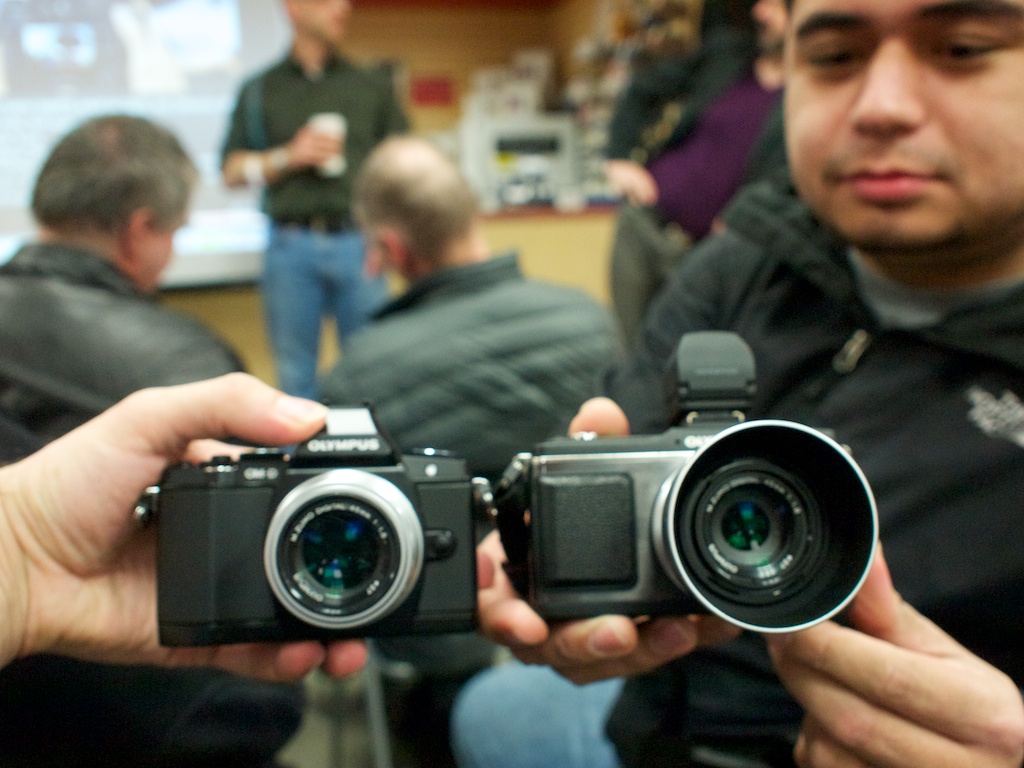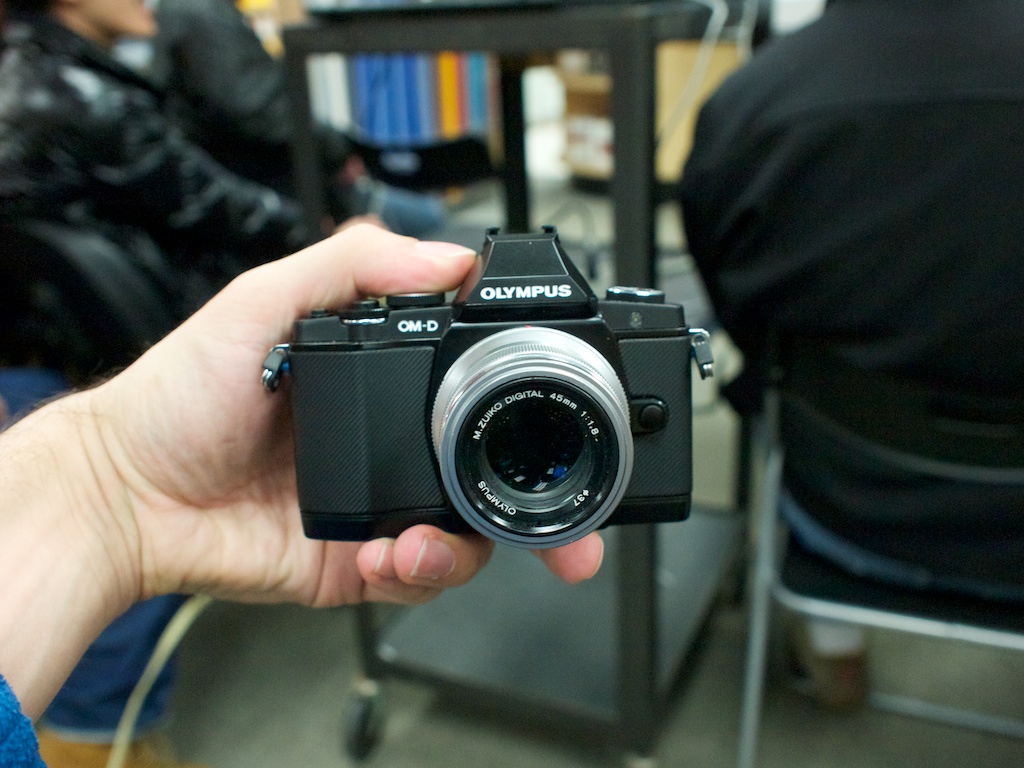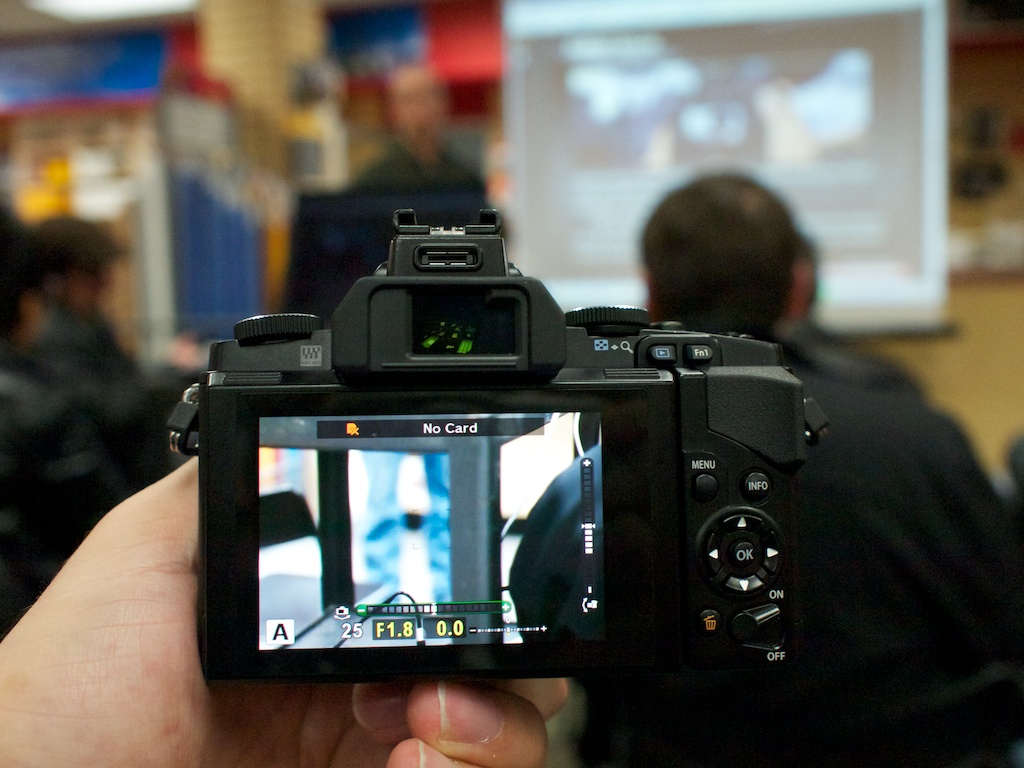I wanted a more compact camera than my DSLR but still with the versatility. The Micro Fourth-Third system (m4/3) was presenting the best compromise, so in November 2010 I bought an Olympus E-P1.
The Micro Four-Third system
m4/3 is a camera system developed by Olympus and Panasonic for a mirror-less through-the-lens digital camera. It is an evolution of the Four-Third system that included a mirror for the viewfinder. By design m4/3 is more compact as it remove that mirror box to use substitute the reflex viewfinder with an EVF. The system standard does not seem to be as “open” as the previous, but it does not really change anything as only Olympus and Panasonic are making cameras, like in Four-Third: the Leica Digilux 3 was just a rebadged Panasonic and Kodak never did anything.
Olympus is very serious about it now that they just announced the OM-D line, starting with the Olympus E-M5, the latest in the m4/3 system, meant to be the spiritual successor of their OM film SLR camera series.
The Olympus E-P1
The Olympus E-P1 or Pen Digital is the first camera Olympus released for m4/3. With a design deliberately retro, it features a small package with a LCD screen in lieu of a viewfinder, interchangeable lenses, no flash (but a hot shoe) and in-body image stabilization. It features a 12 Megapixels sensor with a crop factor of x2, which is quite enough for virtually everything.
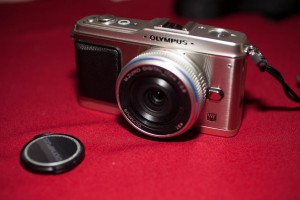
I compared it to the E-P2 and the Panasonic GF1. The E-P2 offered the same as an E-P1 with the addition of an accessory port that allow connecting an EVF, with a higher price. The Panasonic GF1 does not have the IS but allowed and EVF. And it was supposedly a bit faster (more on that later). In the end I chose the E-P1. I love the IS and I miss a viewfinder.
In term of ergonomics, the camera has a rotating selector to select the shooting mode (PSAM, movie and misc), thumb roller to set the aperture or speed depending on the mode, and exposure compensation button and a rotating wheel with 4 direction controller and a central OK button. That last is probably the most cumbersome for my big thumbs as I always end up pressing it when I didn’t want. It allow quick access to ISO, White balance, Auto focus and shooting mode / delay when pressing on one of the four direction. Odd if you try to use the wheel to change exposure in M mode. Maybe it is too small, maybe it should just be the wheel configured differently. I disabled the quick access. You can also configure the 4 way control to set the AF point.
Viewfinder
The camera does not have a viewfinder, just a rear LCD with all the advantage and inconvenience.
Advantage: you can shoot freestyle, from the hip or with awkward angle and still be able to see. It is through the lens, and you have info displayed on it.
Inconvenience: hard to see in the sun, lack the stability of the eye level finder, use the battery.
 E-P1, Leica Summilux 50mm f/1.4, 1/40 f1.4, ISO 1600
E-P1, Leica Summilux 50mm f/1.4, 1/40 f1.4, ISO 1600There is an optional optical viewfinder for the 17mm f2.8 lens that you mount on the hot shoe, but I haven’t tried it. Unfortunately there is no accessory port for the EVF, that’s left to the other models.
Despite the situation not being ideal in my mind, I managed to be able to use the camera without much trouble. It gets used to have a back LCD only, and it is really a bit of a guestimate when in the full sunlight.
The lenses
When I bought my E-P1, it wasn’t available with the 17mm in the store, and buying the body only was more expensive than with the 14-42mm f3.5-5.6. So I got the kit on sale and started with that. The lens is decent, a bit slow on the longer end.
Later I bought the Olympus 17mm f2.8 “pancake” that has become the mostly permanent lens on my E-P1. Excellent choice as it gives an equivalent field of view of a 35mm on 35mm and is reasonably fast.
Other lens choices are the Panasonic 20mm f1.7, then later the 14mm f2.5. These two “pancake” lenses provide excellent image quality. Today Olympus added a 45mm f1.7, a 12mm f2, and there is a bunch of zoom and other third party lenses, including a Leica-Panasonic 45mm Macro f2.8 that is extremely sharp. It is not the lack of choice, and I haven’t listed them all.
 E-P1, Pentax Auto 110 70mm f2.8, 1/320 f2.8, ISO 400
E-P1, Pentax Auto 110 70mm f2.8, 1/320 f2.8, ISO 400If you have an old film camera system, there are plenty of adapters for older manual focus lenses, and that itself is responsible the price rise of older SLR lenses on eBay. There is one for almost anything: Pentax K and M42, Pentax Auto 110, Canon FD, Nikon F, Leica M and LTM. Even better, Olympus sells one for their OM mount. I could never find one for the Fujinon-X mount, probably because these cameras were not very common.
The E-P1 firmware has been designed with that usage in mind. For example the in body image stabilizer must be tuned to the focal length. While this is transparent when the m4/3 lenses are being used, with the manual focus lenses, you set it in the camera menu. While not perfect as it might be a problem with a zoom, it is pretty slick and this alone make it very well suited for that.
Focusing
Using the autofocus is nothing different. It is not super fast, but on overall it is usable. There is also face detection. It sounds like a gimmick but it actually helps if you are taking pictures of people as the autofocus will use it as a target.
To perform manual focus, either on a m4/3 lens or on a “legacy” lens, you have a magnifier on screen. It allow a nice precision, but the camera shake makes it harder than necessary. This is where you miss the EVF. The m4/3 lenses have manual focus by the wire – ie rotating the focusing ring controls a motor that will adjust focus. It works quite well, and it automatically switches the magnifier on as do it. There is also an AF+MF mode that allow full time control while still using autofocus. You can always achieve defocused image or just re-adjust as you please.
 E-P1, M.Zuiko 17mm f/2.8, 1/30 f/3 ISO 1600
E-P1, M.Zuiko 17mm f/2.8, 1/30 f/3 ISO 1600Still there are cases where it doesn’t cut it. I tried to use the E-P1 to take picture of dogs at a Boston Terrier meetup, and it didn’t work out well.
In the field
For a while the E-P1 was the only camera I used. The Canon 5D MkII was left behind. It was much lighter and still very capable.
I heard lot of complaint about shutter lag and autofocus speed, which to be another aren’t that fast, but in general it performs as expected in the streets and in bad weather.
I went on train trip from Vancouver to Toronto, 3 days and 4 nights each way. I decided to not use the 5D MkII an stuck to the E-P1, with only the 17mm. No regrets, I could get what I wanted when I needed, which is what one would expect. In fact during the whole trip I only use the 5D MkII on two situations. One for low light portraits, where 50mm f1.4 helps, and once because I needed a wider angle inside Union Station with the 24mm. I surely could have done without.
The image stabilizer works pretty well, whichever lens you use and that itself can justify going Olympus vs Panasonic. This is even more important since you lose steadiness by holding the camera in front of your rather than against you with an eye level finder.
The sore point with the battery life. It is not that great and I ended up needing to recharge it every 200 shots or even less, as the LCD drains down power. Fortunately I had an extra battery always ready, and recommend anybody to get that extra.
When shooting outside in plain sunlight, it gets harder. The LCD is completely unreadable. It is not specific to this camera ; even my phone can’t be used in this circumstance.
 E-P1, M.Zuiko 17mm f/2.8, 1/320 f/6, ISO 100
E-P1, M.Zuiko 17mm f/2.8, 1/320 f/6, ISO 100Low light
One of the things one expect with a modern camera is to be able to shoot in low light. The m4/3 system has a few fast prime including the Panansonic 20mm f/1.7 or even the M.Zuiko 17mm f/2.8.
At ISO 1600 the camera really show noise. It is still usable, but it gets a bit too grainy to my taste, even more compared to other DSLR (with a larger sensor). Nonetheless it will beat most of the point and shoot that have a smaller sensor. Of course, ISO 3200 is even more noisy.
The user base
Shortly after my purchase I discovered that there was a Vancouver Four Third group on Flickr with a bunch of dedicated users to Four Third and now mostly Micro Four Third. They love the system and beside some film camera, only use that, sometime with a mix of Olympus and Panasonic bodies and lenses.
That offered me the possibility to test the Pentax Auto 110 70mm, the Panasonic 20mm f/1.7, the Panasonic 45mm f2.8 Macro, and others.
 E-P1, Panasonic 20mm f/1.7, f/2 1/400, ISO 100 – color shift in Aperture
E-P1, Panasonic 20mm f/1.7, f/2 1/400, ISO 100 – color shift in ApertureThis reminds me of RFF meetups. I don’t remember Canon dedicated user base.
In conclusion
The Micro Four-Third system is very capable and thrive with a decent choice of body and lenses, where both Panasonic (with Leica) and Olympus are committed, helped with other third parties and “legacy” lens adapters. There is a good selection of fast prime lenses as well as more consumer oriented zooms.
If I had to redo the choice, I’d get the E-P2 because of the EVF (today it would be the E-P3 that is also faster). I also wouldn’t buy it with the 14-42 and instead get it with the 17mm, and maybe another lens, like the 45mm. Today when you compare the E-P2 + EVF with the newly announced E-M5, it is highly possible that the E-M5 is the way to go.
I still feel uncomfortable with the LCD as the only viewfinder, and this may explain my interest for the Fujifilm X-100 and now the X-Pro1: the hybrid viewfinder presenting the actual innovation in that area.
Today, the E-P1 gets a premium place in my bag as the camera I have with me over the DSLR or any of my film gear, even though, sometime, I may have the Ricoh GR-D 2 on my belt instead.
Gallery
Below a few more pictures I took with the E-P1. Some might have been a bit post-processed.
 E-P1, Leica Summicron M 90mm f/2, 1/500 f/2, ISO 400
E-P1, Leica Summicron M 90mm f/2, 1/500 f/2, ISO 400 E-P1, M.Zuiko 14-42mm f/3.5-5.6 @29mm, 1/50 f/7, ISO 400
E-P1, M.Zuiko 14-42mm f/3.5-5.6 @29mm, 1/50 f/7, ISO 400 E-P1, M.Zuiko 14-42mm f/3.5-5.6 @14mm, 1/10 f/5.6, ISO 3200
E-P1, M.Zuiko 14-42mm f/3.5-5.6 @14mm, 1/10 f/5.6, ISO 3200 E-P1, M.Zuiko 17mm f/2.8, 1/320 f/8, ISO 100
E-P1, M.Zuiko 17mm f/2.8, 1/320 f/8, ISO 100 E-P1, M.Zuiko 14-42mm f/3.5-5.6 @42mm, 1/80 f/8, ISO 100
E-P1, M.Zuiko 14-42mm f/3.5-5.6 @42mm, 1/80 f/8, ISO 100 E-P1, M.Zuiko 17mm f/2.8, 1/15 f/2.8, ISO 400
E-P1, M.Zuiko 17mm f/2.8, 1/15 f/2.8, ISO 400
